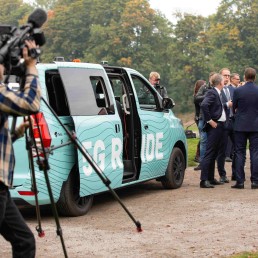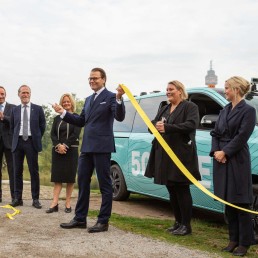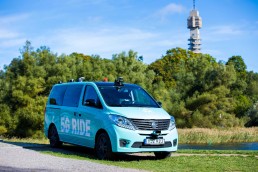Driving the future: Insights from Future 5G Ride
How can autonomous vehicles be safely integrated into public transport systems? And what does it take to manage them without a driver behind the wheel?
Over the past 3.5 years, the Future 5G Ride project has explored these questions—serving as a testbed for connected, driverless mobility. It combined 5G, AI, and smart infrastructure to investigate how autonomous vehicles can operate safely as part of a broader transport ecosystem. This included coordination between vehicles, infrastructure, and the digital systems used for supervision and traffic management.
Led by Kista Science City and involving a broad mix of partners from industry, academia, and public transport, Future 5G Ride focused on practical integration. Vehicles, sensors, and operations were connected and tested together to explore how autonomy could work at scale.

What we learned
Autonomy begins with the system
A key lesson from Future 5G Ride is that autonomous public transport can’t rely on vehicle intelligence alone. To be safe, scalable, and effective, it needs to be part of a larger system—connected not just to other vehicles, but to roadside infrastructure and human operators.
The testbed explored what that system looks like in practice: vehicles, infrastructure sensors, and control centers working as one. This fleet-based model makes it possible to coordinate operations centrally, respond in real time, and scale autonomy for everyday use in public transport.
Safety comes from shared awareness
Future 5G Ride showed how combining infrastructure sensors with AI-supported monitoring can address two distinct safety challenges in driverless public transport: situational awareness around the vehicle, and passenger safety inside it.
Roadside sensors helped detect pedestrians and traffic changes, extending the vehicle’s awareness beyond what onboard systems could see. This improved its ability to respond to external conditions in real time. Inside the vehicle, AI-assisted monitoring focused on passenger well-being—detecting incidents or unusual behavior that could require remote intervention.
Together, these capabilities showed how operations can be safely supervised from a distance, reducing the need for onboard staff while improving working conditions overall.
“To be safe, efficient and comfortable in intensive urban traffic, autonomous vehicles need to be aware of all surrounding road users,” says Dr. Yuri Tarakanov, Research Manager at Viscando. “Future 5G Ride gave us the chance to demonstrate how infrastructure sensors can extend the situational awareness of autonomous buses—especially in dense urban settings where vulnerable road users and cars can be hidden from the autonomous vehicle by for example building walls or vegetation.”
Reliable connectivity is the key to future deployment
The testbed made clear that real-time autonomy only works when networks are ready for it. Remote supervision, live data-sharing, and system-wide coordination all depend on robust, low-latency communication, especially in complex urban settings. By testing both public and private 5G networks, the project highlighted what reliable connectivity actually looks like in practice—and why continued network development is critical to scaling autonomous transport beyond isolated pilots.
Collaboration that drives innovation
Future 5G Ride brought together partners from across sectors—each contributing the capabilities needed to develop, test, and validate autonomous transport in operational settings:
- Tech leaders (Ericsson, Telia, Intel) provided advanced 5G and AI capabilities.
- Innovative scale-ups (Applied Autonomy, Viscando) introduced new solutions and fresh perspectives.
- Public transport authorities (Vy, Region Stockholm) ensured the project’s relevance and practicality in real-world conditions.
- Academic research institutions (KTH, ITRL) provided insights into societal impact, human interaction, and scalability.
“Future 5G Ride gave us valuable confirmation of how to work across the value chain. The experience has helped us scale cybersecure, operational solutions across Sweden and internationally—and we’re happy to share what we’ve learned to support safer, more sustainable mobility.” — Olav Madland, CEO of Applied Autonomy.
The road to deployment
Future 5G Ride is now complete—but its outcomes point forward.
By deploying autonomous public transport in active traffic scenarios, the testbed helped show what it takes to move from isolated pilots to scalable, system-level solutions. It validated core technologies and clarified what’s still needed to make autonomous public transport a part of everyday life.
To move from testing to widespread use, several things still need to be in place:
- Scalable integration of autonomous systems across cities and public transport networks
- Robust 5G infrastructure across more geographic areas and real-world use cases.
- Clear policy frameworks to support safe, large-scale deployment
- Public trust to enable adoption and long-term success.

“HRH Prince Daniel at the launch of Future 5G Ride, 24 September 2020. Autonomous transport has come a long way since.”
“Future 5G Ride has shown what it really takes to make autonomous public transport work — not just removing the driver, but rethinking the entire system around them. By combining 5G connectivity, AI monitoring, and remote supervision with a strong collaborative model, we’ve shown how we can build systems that can truly move public transport forward.” — Lucas Uhlén, Project Manager at Kista Science City.
As coordinator of Future 5G Ride, Kista Science City helped bring together partners from across sectors—creating the conditions for practical testing, shared learning, and long-term collaboration. We’ll continue to support initiatives like this to strengthen Sweden’s role in mobility innovation.
Want to get involved?
Reach out to Lucas Uhlén at lucas.uhlen@kista.com

